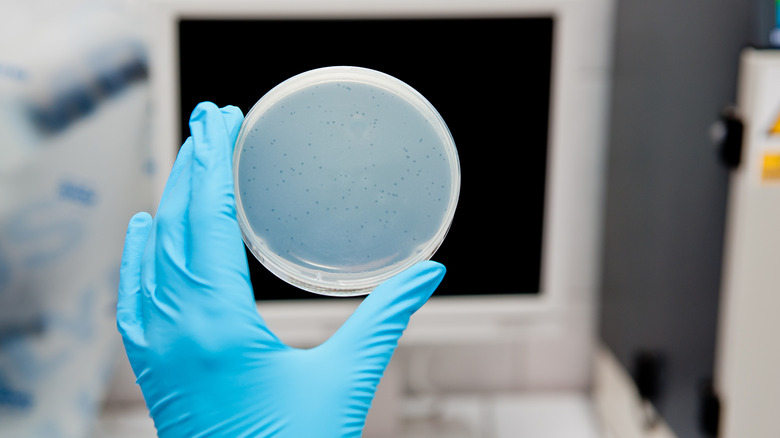Can Bacteria And Viruses Get Infections?
We've all been sick at one point or another in our lives. Whether we've come down with COVID-19 or the common cold, no one is exempt from the discomforts of disease. But have you ever wondered if your cold can come down with a cold? Or if your infections can get an infection?
They can, and it's much more common than most people would suspect. There is a slew of viruses that only infect bacteria, and they're called bacteriophages. And don't underestimate us when we say "slew": there are 10 to the power of 31 bacteriophages on the planet. That's a one with 32 zeros behind it. That's more than any other organism on the planet combined (via UC San Diego Health).
Viruses that infect other viruses aren't quite as widespread as bacteriophages, but they do exist. They're known as virophages, and we've only known about them since 2008 (via Virology Blog). Even if you've never heard of them, bacteriophages and virophages are on the cutting edge of medicine. Don't be surprised if you start to hear more about their clinical use in the next few years.
Félix d'Hérelle
The first recorded observation of bacteriophages was by Frederick W. Twort in England. Although his results, published in The Lancet in 1915, recorded the effects of bacteriophages, he didn't know what he was looking at — he merely remarked upon it and moved on to other research.
On the other side of the English Channel, a French-Canadian named Félix d'Hérelle was working at the Institut Pasteur, looking for a treatment for dysentery (via The New York Times). He observed that there was something killing the bacteria in stool samples taken from afflicted soldiers and correctly deduced that a virus exclusive to bacteria was causing them to die. He set out to turn this discovery into a viable medical treatment (via the World Journal of Gastrointestinal Pharmacology and Therapeutics).
Per Virology Blog, he called these viruses bacteriophages from the Greek word "phagein," which means "to eat." By 1919, he had used bacteriophages to treat dysentery in pediatric patients. In the '30s, he traveled to India and successfully used phages to treat cholera. A few years later, he was invited to the Soviet Union, where he helped to establish what would become the world's foremost center for phage research in the Republic of Georgia (via The New York Times).
Rise and fall and rise again of bacteriophages
Within 10 years of their discovery, phages were being produced around the world to treat an assortment of ailments. But because they weren't well understood, many mistakes were made in their preparation, which negatively affected their efficacy and led to a general distrust of them in the West (via Advances in Virus Research).
At about the same time phages were being extensively tested, Alexander Flemming had discovered penicillin. By the '40s, antibiotics were being mass-produced, and phages quickly became a relic of the past (via World Journal of Gastrointestinal Pharmacology and Therapeutics). Meanwhile, in the Soviet Union — specifically Georgia — research into phages continued. The Soviet medical community led the world in phage therapy research throughout World War II and into the Cold War. In fact, they were the only ones pushing it forward.
The West began a reassessment of phages right at the end of the 20th century. The rise of antibiotic-resistant microbes meant that once-reliable antibiotics like penicillin were no longer effective in fighting off some strains of infection. Some scientists hope that bacteriophages will be the answer to this problem (via The New York Times).
Phage therapy today
Although clinical treatment with bacteriophages has been common in the former Soviet states for decades, the regulatory agencies of the West have been slow to incorporate them into their regulations. For example, some phage therapies are available over-the-counter in Georgia, but in the United States and Europe, it's not generally approved for human use (via Healthline).
One reason the U.S. Food and Drug Administration hasn't approved any phage treatments is one of the reasons they are so effective. Antibiotics are static molecules — they don't change. Bacteria, on the other hand, do change and evolve, so when bacteria evolve resistance to a particular antibiotic, that's it — that particular antibiotic is no longer effective. Conversely, phages are viruses, and they continue to adapt to bacterias' defenses. But that protean potency means that every time a phage evolves, it needs to be reapproved by the FDA, a process that is arduous and expensive (via Popular Science).
Despite this, many doctors have fallen back on phage therapy with great success when they've run out of other options. One case in San Diego involved a 69-year-old patient who had returned from a vacation in Egypt with a severe pancreas infection that resisted all antibiotic treatment. After slipping into a coma for two months, his doctors turned to phages as a last resort. Two days after treatment, he woke up and went on to make a full recovery (via UC San Diego Health).
Virophages
The history of virophages is much shorter than their bacteria-destroying cousins. They were first discovered in 2008 in a cooling tower in France. Scientists were looking at a newly-discovered class of viruses called giant viruses (unlike their smaller brethren, these viruses are the size of bacteria). To their surprise, they discovered that the virus was actually harboring another virus (via The Scientist).
To date, virophages have only been found infecting giant viruses. Typically, these giant viruses only infect microscopic marine life, but they have been found in human hosts, and scientists suspect that they may cause pneumonia, though very little has been published on the subject to date (via Intervirology). Thankfully, human infections by giant viruses aren't a widespread phenomenon. If they were, however, virophages could be a potential treatment option. When studying the tiny viruses, scientists found that infection by a virophage significantly reduced the virus output of infected cells (via Frontiers in Cellular and Infection Microbiology).
This is amazing! What's the catch?
The biggest drawback to phage therapy is that it's not universal. Unlike antibodies, phages only target a few types of bacteria, whereas an antibody can be used to target multiple infections. So that means you'll have to take a phage that's been specifically cultivated to fight your particular infection. Another issue is that phages sometimes have to be grown in order to fight your particular infection. There's also the possibility that the phages could swap genetic information with phages already in your body. Usually, that's not a big deal, but there's the possibility that a genetic change to an endogenous phage could trigger an immune system reaction that's more serious than the initial infection (via Popular Science).
Nevertheless, these are all problems that were overcome in the Soviet Union, and phage therapy continues to be a common treatment everywhere from Azerbaijan to Ukraine. And given the ever-growing problem of antibody-resistant microbes, perhaps phages will soon be used as a solution.





